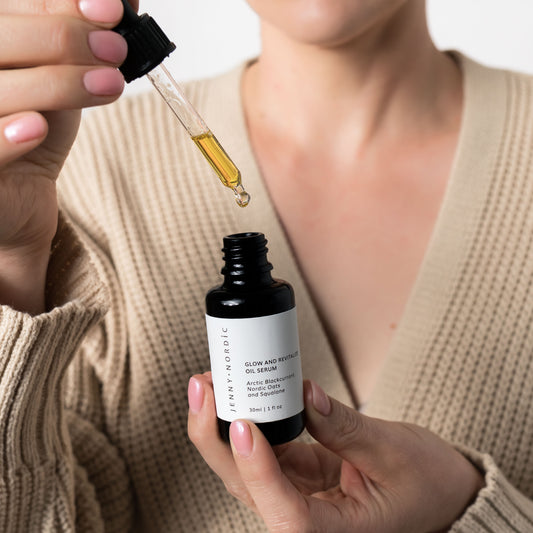
What's my skin type?
Share
An easy guide to skin types and conditions
Knowing your skin type is essential for healthy skin. Choosing the right products to suit your skin type and condition is important, as unsuitable products can cause damage to the skin barrier and cause problems to your skin. With products that suit your skin type and treat your particular skin condition, your skin will be balanced, and look healthy, supple and glowing.
What’s the difference between skin type and skin condition?
There are only three skin types; dry, oily, and normal. When talking about sensitive skin, impure skin, or dehydrated skin, we are talking about skin conditions. These conditions happen when the skin is thrown out of balance due to external factors.
Can your skin type change?
Skin type is something you’re born with, but skin conditions can change throughout life, as well as your individual skin concerns. Skin type is the basis of how to successfully treat your skin condition.
On the contrary, skin conditions can change throughout your life due to internal and external factors.

How to recognise your skin type and condition
You can analyse your skin type easily after cleansing your face with a neutral, gentle cleanser. How does your skin feel after cleansing, before applying any product to it?
Ask yourself the following questions to help recognise your skin type and condition:
- Does your skin feel dry or oily?
- Does the skin feel tight?
- Does your skin feel tight also during the day and in the mornings after you wake up?
- Does your skin start shining during the day?
- Are your pores enlarged and deep?
- Is your skin pale, red, dewy or dull?
Skin types
Dry skin can feel tight after cleansing and also throughout the day. The sebum production of the skin is lower and the skin doesn’t get oily or shiny during the day. Dry skin tends to be thin, which makes it prone to, for example, couperosa and being sensitive. Wrinkles and fine lines can show on dry skin at a younger age.
Unbalanced dry skin can be flaky, dull and feel rough to the touch.
Oily skin is the opposite of dry skin. Its sebum production is increased, the skin shines easily and makeup can easily dissolve away during the day. Pores are visible and can also be deepened.
The most common mistake done whilst taking care of oily skin is to use too harsh cleansing products and peels. This increases the skin's own oil production even more and can lead to congestion and even oilier skin.
Normal skin has a balanced sebum production. The skin doesn’t feel tight in the mornings or after cleansing. The skin feels soft to the touch and looks dewy, regardless of age.
You can unbalance normal skin as well by using too harsh cleansers, and forgetting about proper hydration and moisturising.

Skin conditions
Skin conditions occur usually due to an imbalance in the skin. Weather conditions, lack of care, wrong skin care products, stress and lack of sleep amongst others can all cause an imbalance in the skin. Your skin can react to these factors in different ways. The best part of skin conditions is that with the right care, they can be reversed and skin balanced. Let’s go through some of the most common skin conditions.
Dehydrated skin lacks water and hydration. Dehydrated skin doesn’t shed off the dead skin cells and the skin starts looking thick, dull and feeling rough. Dehydrated skin gets congested easily which can cause the skin to break out. Dehydrated skin benefits from acids as they help increase skin cell turnover and balance the naturally acidic pH of the skin. Swap thick creams with hydrating essences and mists and seal them in with a good quality organic face oil.
Read more on how to treat dull, dehydrated skin here.
Sensitised skin can feel itchy, turn red, and also get a burning sensation. Caring for sensitised skin can be difficult as every sensitive skin is different. What helps one can cause another a reaction. As a rule of thumb, keeping your skincare routine simple and avoiding scrubs, peels and hot water helps. Finding the right products can take time.
Both dehydration and sensitisation can react as impure skin. It’s important to act against the natural urge to start cleansing the skin with stronger cleansers, peels and scrubs and forgetting about nurturing the skin. Changes in hormones, stress levels and diet can also cause impurities and breakouts.

How to choose the right skincare for your skin
It can be challenging to know which product is the right for your skin. The market is very saturated and full of loud noise and advice. That’s why being clear on your skin type is so essential.
The skin condition you’re dealing with at the moment then further dictates the products and treatment for your skin. It’s a balancing act - the aim is to bring your skin back to balance, to its healthy self.
Start minimal and stick with what works for you. There’s no need to repair something that’s not broken. Taking it back to the basics is important especially if your skin is reactive, sensitive or dehydrated.
Try a minimal approach to skincare, and once you’ve found products that work for you and your skin is happy and in balance, you can start adding to it. Choose products that maintain and help strengthen the skin barrier as a strong and healthy barrier is the main building block for balanced, glowing skin.
Learn more about Jenny Nordic Balance & Glow Ritual here.
PS. Follow us on Instagram for daily skincare tips and inspiration!









